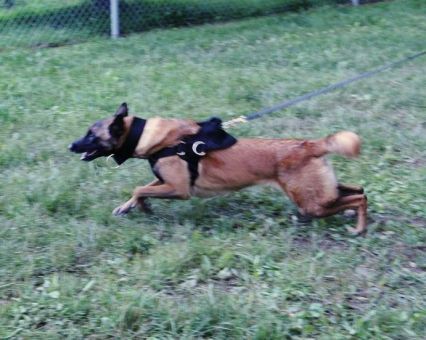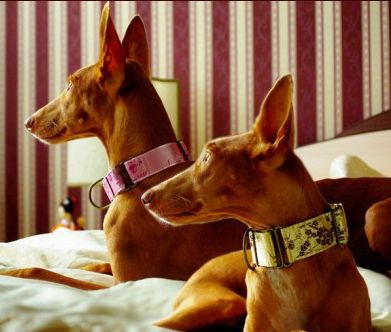
Just some food for thought: The above photo shows how many sensitive things are found in a dog’s neck and how pressure on those things can cause or worsen certain conditions. Clipping a leash to a dog’s collar is one of those “we’ve always done it” sort of things and mostly it works out fine for the dog as far as I can tell. They might need some chiropractic adjustments or might cough when they pull, but that’s normal, right? But is it okay for a growing puppy to be stressing the nerves, joints and tendons in their neck each time the handler or the pup pulls on the collar? I honestly don’t know.
It seems like most dogs turn out fine and only some end up with collapsed trachea or nerve damage or other such issues that might be caused or aggravated by years of constriction on their necks.
Obviously dogs have to wear collars if they are going to compete since most venues don’t allow harnesses. So dogs have to get used to working with a leash attached to a collar. But personally, I will be keeping my puppy on a harness as long as possible while he learns leash manners because it can’t hurt, and might help prevent issues down the line.
Harnesses move the pressure to the dog’s body and away from the sensitive neck.

But there are vast differences in harness types and how they affect the dog’s body. The type that constrict on the dog’s shoulders may be linked to shoulder issues later in life when used on growing puppies. And harnesses that have a chest strap across the front of the dog’s shoulders can also restrict full motion of the dog’s front legs. So a non-constricting, “V- front” harness with a strap between the dog’s front legs to prevent the neck pieces from moving into the neck seems to be the best choice. Or the wide strap or padded/cloth type that help spread the pressure. And a chest ring, like the one on this Chai’s Choice Front Range Harness lets you clip the leash to the chest, making it easier to control where the dog’s body is going and makes it harder for the dog to pull.
I’m currently using the Premier “Sure-fit” harness on Voodoo because it’s what I had in the size he needs and it has a non-constricting, full motion V front with a chest ring and every strap is adjustable on it.
Another option is the Perfect Fit harness by Dog Games, Ltd.

Obviously training is the most key component to getting a dog that walks nicely on a leash, but the equipment on the dog can aid the training if it’s the right equipment being used correctly, including harnesses.
As for collars, the wider the better to help distribute the pressure over a wider area and reduce the digging in caused by narrow collars. Compare the photo below with a wide collar to the ones at the top of this article.

You can find wide collars by searching the internet for “Greyhound collar”, “Greyhound martingale”, or “extra wide dog collar”. Another nice thing about the wider collar is that the design is more visible and it doesn’t damage or discolor the dog’s hair like some collars, especially if you get a fleece lined one. 🙂 The martingale design is really nice because it will tighten enough that the dog can’t slip out of the collar, but can’t tighten enough to choke or put too much pressure when it’s properly fitted. Great for dogs with thick necks or with heads that are smaller than their neck.

As I said at the start, this is just food for thought. If you’re happy with what you are using, stick with it! If not, there ARE options to consider.






Interesting article. I am very lucky as I have 2 rescue GSD X’s, both wear collars safely because neither of them pull on a lead. Sally is a Spanish rescue, GSD X Galgo and she wears a wide martingale collar and Uma is an Irish rescue, GSD X Collie and she wears a standard collar. I think a dog that pulls a lot would be more comfortable in a harness but is it harder to train them to heal in a harness?
LikeLike
Using the front attach ring, it’s not any harder to train the loose leash walking and may even be easier with a properly fitted front attach harness.
LikeLike
Great article but you might want to mention the Perfect Fit harness by Dog Games Ltd as thats their excellent graphic you have used here.
LikeLike
Done, thanks
LikeLike
I’m surprised no one has suggested not using a lead to train your puppy to walk nicely by your side just train from very early of leash walking close to me is the best place to be with food toys reward etc takes lots of time and patience and the use of very safe places to practice
LikeLike
While that is ideal, it doesn’t work for very many people. And safe places that also introduce distractions that the puppy will be interested in, but can’t get to, are even harder to find. It’s a great way to get the initial concept while at home or in your yard, but once in public most people need a leash to keep the pup from charging into trouble 🙂 And since most people wait to work on it till the pup hits the independent stage and stops following them naturally, that makes it even harder.
LikeLike
My pug is a puller. He’s doing great using his new Freedom No Pull Harness in conjunction with the leash (sold separately). There is an attach ring in front and at the neck and on the top of his back and the leash hooks to both which really has helped him learn not to pull. We love it and he prefers. Under the arms the straps are like velvet. This was recommended to me by the staff at Velvet Ears which is part of Douglassville Veterinary Hospital.
LikeLike
Mine used collar in school. Because instructor required it. They each have collars with name and phone number on it. But the wear harnesses when walking or riding in car or on golf cart. The. Plats are strictly decoration and harness is for their safety. Because they are well trained. If I pull out the harnesses the get very excited. Because they are going- doesn’t matter where. Just going. They are small Caviliar King Charles and miniature Cocker. Because I live in Arkansas vs Califormia. They are allowed in the water here. They need new water vests. Do you know what make is best thanks Judykumler7@ gmail.com
LikeLike
I haven’t looked at water vests, but the same sort of rules apply about the dog being able to have full range of motion of it’s legs. If the dog can’t move around in it on land, they won’t be any better in water. It should be snug and properly sized.
LikeLike